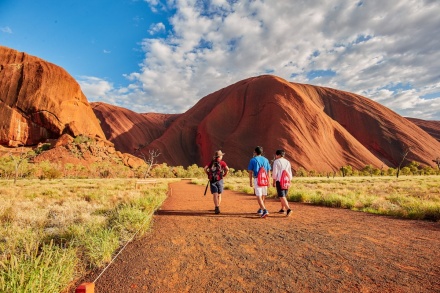
The southern desert region of the Northern Territory in Australia is known as the Red Centre. It is known for it's vast, arid landscapes, iconic red sand, and significant natural landmarks. The Red Centre region is the heart of the Australian Outback and offers a unique environment and spectacualr icons for travellers.
Uluru (Ayers Rock)
This massive sandstone monolith is perhaps the most iconic symbol of the Red Centre and of Australia's natural beauty. It is deeply significant to the local Indigenous peoples, the Anangu, and is a UNESCO World Heritage Site.
Kata Tjuta (The Olgas)
Close to Uluru, Kata Tjuta is another stunning rock formation consisting of 36 domes spread over an area of more than 20 kilometers. Like Uluru, it holds great spiritual significance to the Indigenous people.
Alice Springs
Often considered the gateway to the Red Centre, Alice Springs is the main urban center in this region. It serves as a base for tourists looking to explore the natural wonders and learn about the Aboriginal cultures of Central Australia.
Kings Canyon (Watarrka National Park)
Featuring ancient sandstone walls, palm-filled crevices, and views that stretch across the desert, Kings Canyon offers remarkable walking trails and is a must-visit location in the Red Centre.
MacDonnell Ranges
This mountain range extends east and west from Alice Springs and offers a variety of landscapes, from gorges and waterholes to ancient rock art sites.
The Red Centre is not defined by precise geographical boundaries but is more a reflection of the unique environment and cultural significance of central Australia. It's a region that embodies the rugged and remote beauty of the Australian Outback, offering visitors a chance to experience some of the country's most dramatic landscapes and to learn about Indigenous cultures and history.
Alice Springs, often regarded as the beating heart of Australia's Red Centre, is a vibrant outback town that offers a unique blend of natural wonders, history, and contemporary culture. Situated roughly in the geographical center of Australia, it serves as a key gateway for exploring the iconic landscapes and cultural sites of the region.
Uluru is a massive sandstone monolith, sacred to the indigenous Anangu people and an iconic symbol of Australia's natural heritage.
Witnessing the changing colors of Uluru at sunrise or sunset is a breathtaking experience, with the rock transitioning through a spectrum of reds, oranges, and purples.
Join guided walks around the base of Uluru led by Aboriginal guides who share the stories, history, and cultural significance of the area.
As darkness falls, see the desert come alive with Bruce Munro's solar-powered art installation, Field of Light, illuminating the landscape with thousands of colored lights.
6 Hours Drive from Alice Springs
The Olgas are a group of large, ancient rock formations about 30 km west of Uluru, offering various walking trails that lead through deep valleys and secluded waterholes.
Walking tracks meander through Kata Tjuta's domes, providing stunning views and a deeper connection with the natural environment.